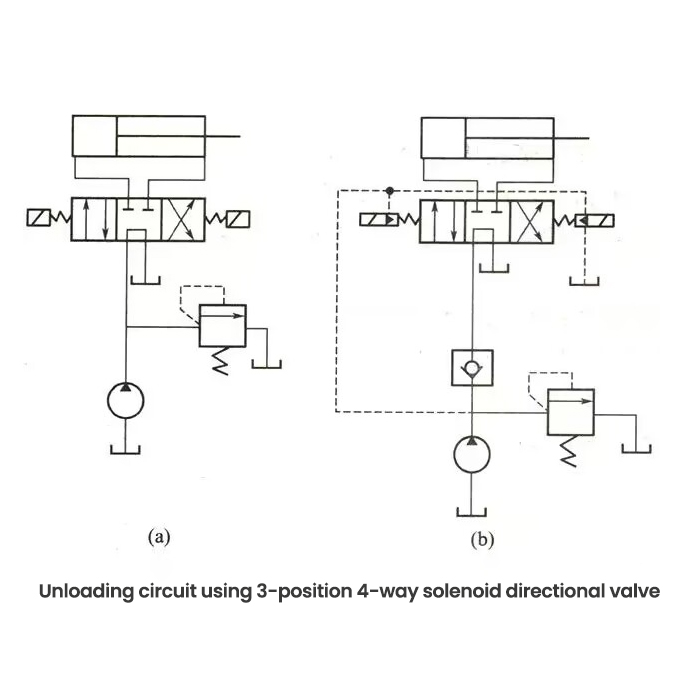Hydraulic shock problem caused by reversing process of reversing valve
Figure 2(a) shows the unloading circuit using a three-position four-way electromagnetic reversing valve, and the median function of the reversing valve is M type. The system to which this circuit belongs is a high-pressure and large-flow system. When the reversing valve is switched, the system will experience a large pressure shock. In addition to the M type, the three-position valve has unloading performance in the middle position, and there are H type and K type. Such a circuit is generally used in hydraulic systems with low pressure (pressure less than 2.5MPa) and small flow (flow less than 40L/min), and is a simple and effective unloading method.
For a hydraulic system with high pressure and large flow, when the outlet pressure of the pump is switched from high pressure to almost zero pressure, or quickly switched from zero pressure to high pressure, hydraulic shock will inevitably occur when the reversing valve is switched. Simultaneously, because the electromagnetic reversing valve is switched quickly and there is no buffer time, the hydraulic shock is forced to intensify.

Replace the three-position electromagnetic reversing valve with an electro-hydraulic reversing valve [see Figure 2(b)]. Since the reversing time of the hydraulic valve in the electro-hydraulic reversing valve is adjustable, there is a certain buffer time for reversing, so that the pump There is a change process for the rise or fall of the outlet pressure, which improves the stability of the commutation and avoids obvious pressure shocks.
The function of the one-way valve in the circuit is to make the pump still have a certain pressure value (0.2-0.3MPa) when it is unloaded, which is used for controlling the oil circuit.
The above analysis is mainly applicable to the hydraulic system of the machine tool, because the hydraulic system of the machine tool does not allow hydraulic impact, and any small impact will affect the machining accuracy of the parts.
For the hydraulic system of construction machinery, it is generally a high-pressure, large-flow system. Most of the reversing valves are M-type. Why is there no hydraulic shock? This is because in the hydraulic system of construction machinery, the reversing valve is generally manual, and the buffering effect when the reversing valve is switched is realized by the operator. The valve port of the reversing valve is also a throttling port. When operating the handle, the operator should gradually open or close the valve port to avoid hydraulic shock.
During the interval between the working mechanism of the hydraulic system stopping and pushing the load to run, or even if the hydraulic pump is running without load under almost zero pressure, the hydraulic pump should be unloaded. This can reduce power consumption, reduce system heating, and extend the service life of the hydraulic pump. Generally, hydraulic systems with a power greater than 3kW should have an unloading function.
